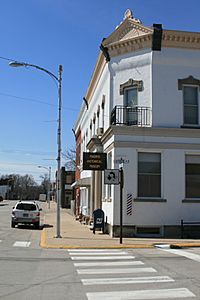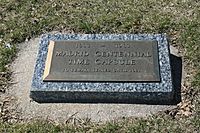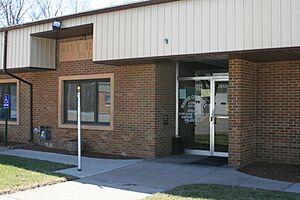Madrid, Iowa facts for kids
Quick facts for kids
Madrid, Iowa
|
||
|---|---|---|
|
City
|
||
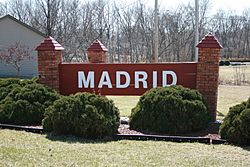 |
||
|
||
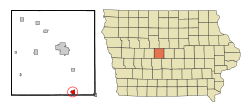
Location of Madrid, Iowa
|
||
| Country | United States | |
| State | ||
| County | Boone | |
| Township | Douglas | |
| Area | ||
| • Total | 1.22 sq mi (3.17 km2) | |
| • Land | 1.22 sq mi (3.17 km2) | |
| • Water | 0.00 sq mi (0.00 km2) | |
| Elevation | 1,017 ft (310 m) | |
| Population
(2020)
|
||
| • Total | 2,802 | |
| • Density | 2,289.22/sq mi (883.64/km2) | |
| Time zone | UTC-6 (Central (CST)) | |
| • Summer (DST) | UTC-5 (CDT) | |
| ZIP code |
50156
|
|
| Area code(s) | 515 | |
| FIPS code | 19-48450 | |
| GNIS feature ID | 0458731 | |
| Website | www.madridiowa.com www.madridiowa.org | |
Madrid (pronounced MAD-rid) is a city in Boone County, Iowa, United States. It's located within Douglas Township. In 2020, about 2,802 people lived there. Madrid is part of a larger area that includes Boone and Ames, Iowa.
Contents
Exploring Madrid's Location
Madrid is found at specific coordinates: 41.875435 degrees North and -93.819931 degrees West. This helps pinpoint its exact spot on a map.
The city covers a total area of about 3.17 square kilometers (1.22 square miles). All of this area is land, meaning there are no large lakes or rivers within the city limits.
Madrid's Past: A Look at Its History
Madrid started as a small community where people farmed in the summer and mined coal in the winter. Over time, coal mining became a much bigger part of the local economy. At first, coal was mainly used by people in the area to heat their homes.
In 1901, the Carpenter Coal Company opened a mine near Madrid. The Reese Brothers Coal Company also opened two mine shafts nearby. The Carpenter Brothers even changed their company name to Scandia Coal Company. By 1914, the Scandia Coal Company was producing over 100,000 tons of coal each year! This made them one of Iowa's top coal producers.
Many people working in the mines were part of the United Mine Workers union. In 1912, two local unions in Madrid had almost 400 members. This was about one-third of the city's total population at the time.
During the 1920s and 1930s, many Italian and Croatian families moved to Madrid to work in the coal mines. In 2017, Madrid was even featured on a Spanish TV show called Madrid de sol a sol. The show explored places around the world named "Madrid."
Population Changes Over Time
| Historical populations | ||
|---|---|---|
| Year | Pop. | ±% |
| 1880 | 200 | — |
| 1890 | 565 | +182.5% |
| 1900 | 1,021 | +80.7% |
| 1910 | 1,191 | +16.7% |
| 1920 | 1,783 | +49.7% |
| 1930 | 2,061 | +15.6% |
| 1940 | 2,074 | +0.6% |
| 1950 | 1,829 | −11.8% |
| 1960 | 2,286 | +25.0% |
| 1970 | 2,448 | +7.1% |
| 1980 | 2,281 | −6.8% |
| 1990 | 2,395 | +5.0% |
| 2000 | 2,264 | −5.5% |
| 2010 | 2,543 | +12.3% |
| 2020 | 2,802 | +10.2% |
| Iowa Data Center Source: |
||
How Many People Live Here? (2020 Census)
In 2020, the city of Madrid had 2,802 people living in 1,160 households. The city had about 883 people per square kilometer (2,288 per square mile). There were 1,227 homes or housing units.
Most of the people in Madrid (about 94.5%) were White. A smaller number were Black or African American (0.6%), Asian (0.3%), or from two or more races (3.9%). About 2.5% of the population identified as Hispanic or Latino.
The average age in Madrid was 39 years old. About 26.3% of residents were under 20. Another 26.9% were between 25 and 44 years old. About 19.3% were 65 or older. The population was almost evenly split between males (49.2%) and females (50.8%).
Population in 2010
According to the 2010 census, Madrid had 2,543 people living in 1,045 households. The population density was about 2,137 people per square mile. There were 1,138 housing units.
The racial makeup was mostly White (98.6%). About 0.8% of the population was Hispanic or Latino.
The median age was 40.2 years. About 24.7% of residents were under 18. About 19.8% were 65 or older. The city had slightly more females (52.9%) than males (47.1%).
Places to Visit in Madrid
Madrid has several interesting places to visit:
- Hindu Temple & Cultural Center of Iowa: A place of worship and cultural activities.
- Snus Hill Winery: A local winery.
- Iowa Arboretum: A large garden featuring many different trees and plants.
- Swede Point Park: A park for outdoor activities.
- Madrid Historical Museum: Learn about the city's past.
- High Trestle Trail: A popular trail for biking and walking, known for its impressive bridge.
- Madrid High School: The local high school.
Famous People From Madrid
- Dick Jensen: A member of the well-known 1969-70 Iowa Hawkeyes men's basketball team.
- Thatcher Johnson: He served as Iowa's Deputy Secretary of Agriculture and ran for other state offices.
See also
 In Spanish: Madrid (Iowa) para niños
In Spanish: Madrid (Iowa) para niños



